
Urinary Incontinence
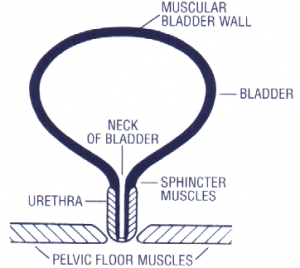
The bladder is supported by the pelvic floor muscles, which in turn is a function of the nerves that supply it and hormonal influence on the muscle tone. Urinary incontinence (UI) is the uncontrolled leakage of urine as a result of loss of bladder or sphincter muscle control. Urinary incontinence can range from leaking as a result of physical activity e.g. coughing or laughing to having leakage that occurs before one can reach the toilet as a result of strong sense of urge. It can also occur as a result of high-grade obstruction of the bladder neck. UI tends to be age-related. Most of the sufferers are elderly women. Though incontinence is embarrassing and restricts one’s social activity, it can be treated.
Evaluation
This is assessed from the history, physical examination and relevant lab / xray investigations. Sometimes, urodynamic tests may be needed; this is the study of the bladder and urethra function by means of a machine connected with tubes and electrodes inserted into the bladder and rectum.
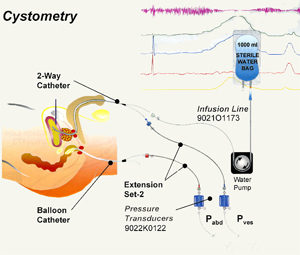
Urodynamics can help determine the type of incontinence, especially in complicated cases.
Types
There are 4 types of incontinence:
Stress Incontinence
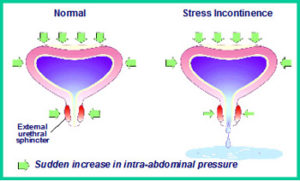
Stress incontinence is commonest in women. Stress incontinence is when urine leaks when the pressure on the bladder overcomes its support on the pelvic floor muscles. Women in particular are prone to this type of incontinence because of weakness in their pelvic floor muscle from childbirth or menopause. Men who undergo radical prostatectomy can also expect to have stress incontinence for some months after the surgery.
Features
- Leak during coughing, sneezing
- Leak when lifting an object or on physical exercise
- Causes
- Aging
- Childbirth from vaginal delivery
- Surgery on pelvic organs or prostate
Treatment
- Slings – eg. TVT, TOT, male sling
- Colposuspension – open or laparoscopic
- Bulking agent injection – e.g. collagen
- Artificial urinary sphincter
Urge Incontinence
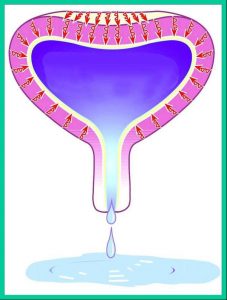
This is seen in those who have severe overactive bladder (OAB). Urge incontinence occurs when the OAB is of a severe degree (also known as “OAB wet”). The need to urinate comes on very suddenly, and leaks before reaching the toilet. Urge incontinence affects all age groups although it mostly afflicts the elderly.
Features
- Leak due to a strong urge to pee
- Leak before reaching the toilet
Causes
- Ageing
- Cold weather
- Excess caffeine
- Mental stress
- Childbirth
- Stroke
Treatment
- Drugs to inhibit bladder contraction (anti-cholinergics or beta3 agonist)
- Botox injections into bladder muscle
- Neuromodulation of the sacral nerve
- Surgery to enlarge the bladder (auto-augmentation)
Mixed Incontinence
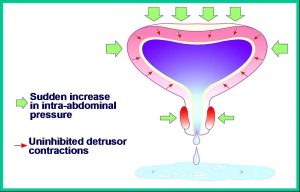
This is a combination of stress and urge incontinence and seen in up to one-third of women who have stress incontinence. Leakage may be due to physical stress or due to a strong and sudden urge. Because of the mixed picture, this incontinence can be a bit more difficult to diagnose and treat compared to other types of incontinence. Often, urodynamics is needed to differentiate which is the predominant mechanism causing the incontinence.
Features
- Leak upon coughing, sneezing and straining
- Leak due to a strong urge to pee
Causes
- Ageing
- Childbirth via normal vaginal delivery
- Cold weather
- Excess caffeine
- Mental stress
- Stroke
Treatment
- Drugs to inhibit bladder contraction (anti-cholinergics)
- Slings – eg. TVT, TOT
- Colposuspension – open or laparoscopic
- Bulking agent injection – eg. collagen
Overflow Incontinence
This type of incontinence is the uncontrollable leakage of small amounts of urine caused by an overfilled bladder. The feeling is that of inability to empty the bladder despite straining and leakage upon minor exertion e.g. getting up from lying position, coughing. This often occurs in men who have an enlarged obstructive prostate (BPH), and in rarely, those with a large tumour in the pelvis. Diabetes or certain medicines may also cause this problem. Overflow incontinence can be indistinguishable from stress incontinence.
Features
- Sense of incomplete emptying despite straining to empty bladder
- Leak upon change in position from lying to sitting or standing position
- Leak before coughing or sneezing
Causes
- Ageing
- Enlarged prostate
- Pelvic tumour
- Diabetes mellitus
- Spinal cord injury resulting in paralysis of the lower half of the body
- Pelvic surgery resulting in destruction of pelvic nerves
Treatment
- Catheterisation – either self or assisted
- Drugs to improve bladder contraction (cholinergics)
Summary
There are many types of urinary incontinence. It is important to categorise the type of incontinence and understand the pathologic mechanism before correct treatment can be given. If corrective surgery is needed, it is crucial that it is performed by experienced surgeons as the success rate for re-do surgery is poorer.